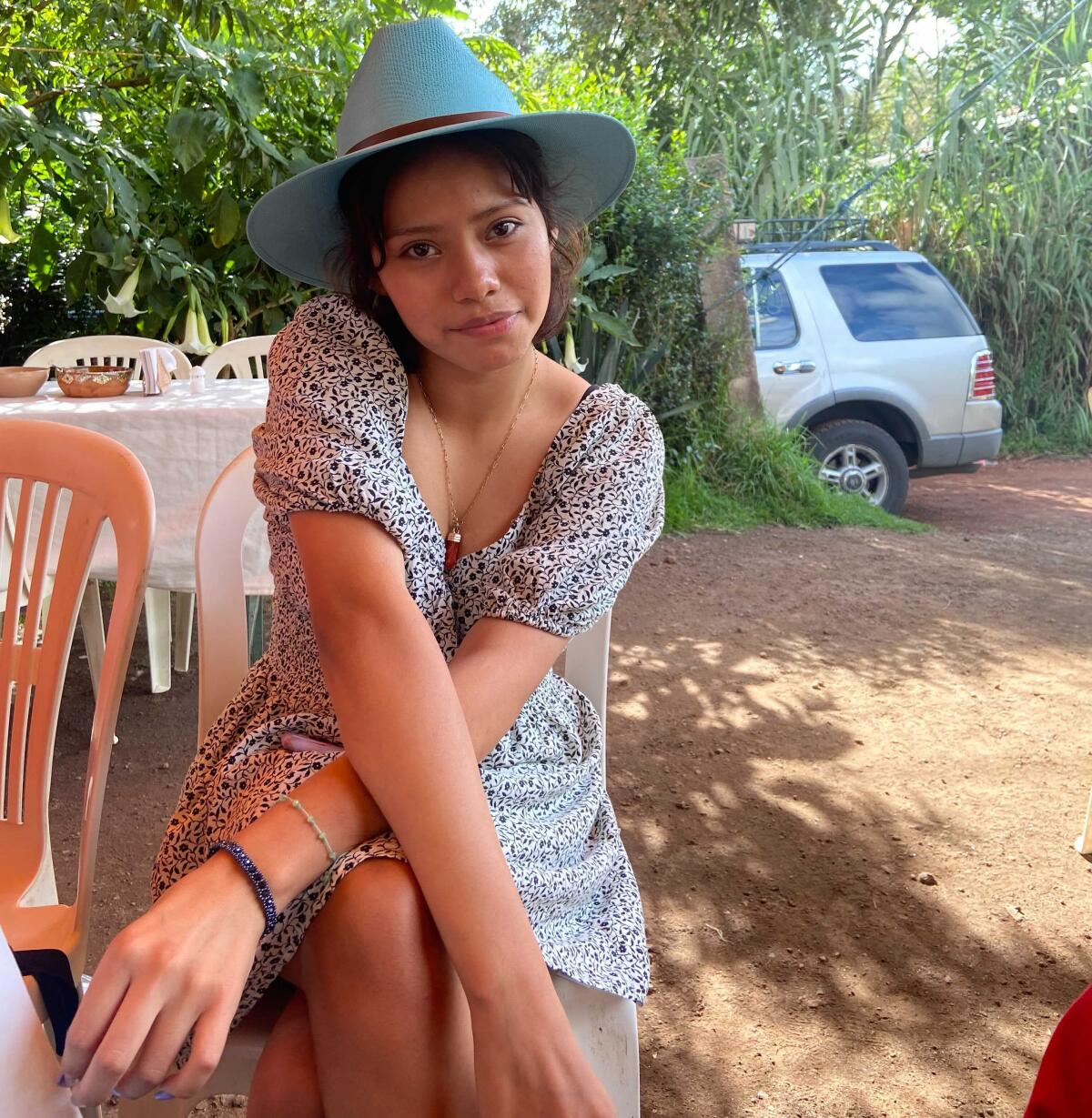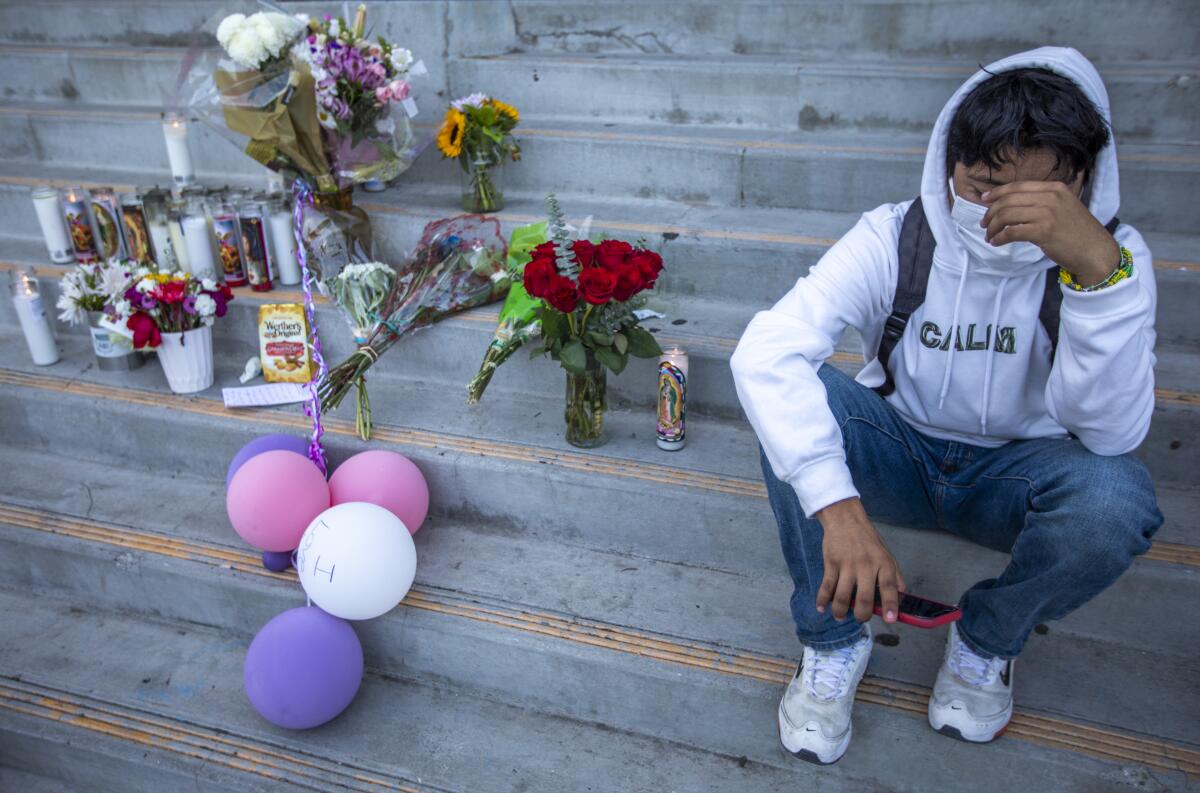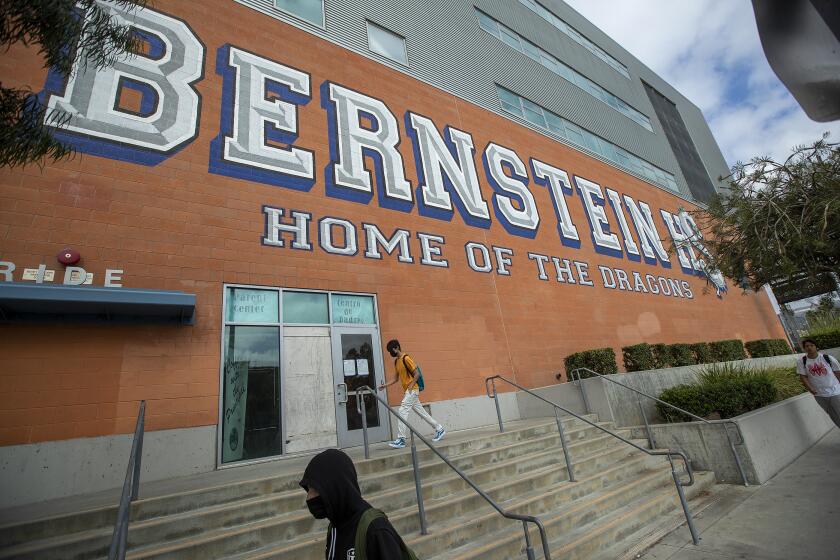‘One pill kills’: Student’s overdose death prompts urgent action among educators, police

- Share via
Melanie Ramos, a 15-year-old student who died of a drug overdose this week at Helen Bernstein High School in Hollywood, loved to travel, dreamed of one day joining the Army and was best friends with her sisters.
“Full of life,” is how a family member described her — and as far as they knew, Melanie did not use drugs.
“You can tell when a kid struggles in any sense. They shut themselves out and they don’t want to be social, not even with family members, but that wasn’t the case here,” said Gladys Manriques, a family member who spoke on their behalf. “She was very respectful, and she made sure she let her mom know where she was at all times.”
On Friday, Melanie’s family — and an entire school community — were reeling from the girl’s death. The teen and a friend are believed to have bought pills containing deadly fentanyl from a 15-year-old boy on campus who has been arrested on suspicion of manslaughter. Melanie’s body was found in a school bathroom, a jarring breach of the haven that schools are expected to provide and a young death that casts a harsh spotlight on the exploding fentanyl pill drug crisis in Los Angeles.
“I think we were failed in many directions,” Manriques said. “This pill is poison. I call it the devil pill, and it’s going to continue unless you start breaking down the chain.”
In the aftermath, top city leaders — Mayor Eric Garcetti, L.A. Police Chief Michel Moore and schools Supt. Alberto Carvalho — have pledged urgent action as on-the-ground law-enforcement officials bluntly described the massive and dangerous influx of drugs.

“One pill kills,” said LAPD Capt. Lillian Carranza, who oversees the gang and narcotics division, adding that the term “fentanyl-laced” is a weak misnomer. “It is straight up fentanyl. It is not laced with fentanyl... We recovered hundreds, if not thousands, of pills a day; 10,000 pills every other day isn’t unusual” for drugs that are cheap to make and transport and “pushed hard by drug dealers and the cartels.”
“Tell your children: You can’t tell if drugs contain fentanyl by look, taste, smell or touch,” Garcetti said. “A dealer may be a friend or so-called friend or classmate. They might not even know what substance they’re providing.”
Moore pledged swift justice up the distribution chain.
Two teenage boys were arrested, one in connection with the fentanyl overdose death of 15-year-old Melanie Ramos, according to authorities.
“These were students selling to students,” Moore said, “and we’re looking for the people who are using them solely for their access to this campus.” He said that public awareness — leading to prevention — is the best strategy, but that it also would help to put school police on campus.
Carvalho said that at least in the short term, he will increase security on the Bernstein campus, which also houses two other schools. He also wants to double down on the school system’s existing public awareness campaign and to work with public and private entities to provide more activities and safe spaces for students.
Amid their grief, Melanie’s family expressed anger Friday, saying the school system has failed to protect students — and “our Melanie has to be the example.”
Melanie’s 15-year-old friend also overdosed and was hospitalized. Melanie thought she had obtained Percocet, an addictive opioid risky on its own, that doctors prescribe to help relieve moderate to severe pain, police said.
In addition to the 15-year-old suspect, a 16-year-old boy was arrested on suspicion of narcotics sales for allegedly selling pills at nearby Lexington Park on Tuesday to a third student, a 17-year-old boy from Hollywood High School. The identities of the arrested boys were not released because they are minors. They are students at Apex Academy, a charter school on the Bernstein campus.
Police said there was a fourth student who overdosed at the park, but her identity is not known.
It is “startling” for this to occur on a campus, where there is an expectation of safety, but these pills can be obtained readily and taken anywhere, said Dr. Gary Tsai, director of substance abuse prevention and control for the county health department, which issued an alert Thursday about the growing danger of the illicit pills.
“Someone can take that in any setting, right?” Tsai said. “Could be a school bathroom, library bathroom. Could be a church bathroom. And that’s the scary part. And it’s a risk for someone who’s never [before] used as a drug in their life.”
In 2021, the alert said, fentanyl was identified in about 77% of adolescent overdose deaths nationally, and 2015 data showed that more than 80% of drug overdose deaths among adolescents ages 15 to 19 were unintentional.
A 15-year-old died Tuesday from a fentanyl overdose at Bernstein High School in Hollywood while three other students were hospitalized, the LAPD said.
“Fentanyl and methamphetamine-related overdose deaths have increased in Los Angeles County even prior to the pandemic and continue to rise at an alarming rate,” the alert noted.
The deadly impact of illicit pills can be profound, with fentanyl being 100 times stronger than morphine and 50 times stronger than heroin, according to the federal Centers for Disease Control and Prevention. Social media has made drug dealers more available to addicts and teens seeking something to calm their anxiety and thinking they are getting prescription medication, public health and law enforcement experts said.
Students leaving school Friday afternoon — amid a makeshift memorial to Melanie — said some teachers spoke briefly about the danger of drugs, but there has not been a concerted, widespread campus education campaign since the incident.
Stephany Ramirez, a ninth-grader at STEM Academy of Hollywood, also on the Bernstein campus, said her teachers have been talking to students about Melanie’s death and asking them how they feel about it.
“In one of my classes today, we were doing stations and one of the station areas was what should be done to make it stop happening,” she said.
Maria Agueda, Stephany’s mom, said the district contacted parents, telling them they’re going to warn students about the dangers of drug use. Agueda said she supports police bringing in canines and conducting random and unannounced searches for drugs on campus.
Naomi Corado, a ninth-grader, said teachers told students this week to be careful about drugs. The school postponed an assembly originally planned for Friday to next week because of Melanie’s death, Naomi said. She believes the district plans to address drug use during the next assembly.
Naomi’s mother, Norma Arteaga, said she was worried about what was happening on campus.
“I want more security so kids don’t bring in drugs,” she said in Spanish.
L.A. Unified provides drug-abuse education at every grade level, said Timothy Kordic, project advisor for health education programs in the district’s Division of Instruction. And materials have been updated specifically to include fentanyl risks in what district specialists consider an age-appropriate manner.
The district approach combines providing information with teaching and rehearsing life skills, such as resisting peer pressure. It’s about eight to 16 hours of class time per year, Kordic said.
In addition, high school students must complete a one-semester health course — which covers the topic — as a graduation requirement.
Though it’s always necessary to update and review what’s being taught, Kordic said, helpful additional steps could include enhanced training for teachers, more direct outreach to parents and the creation of more peer groups.
Glenn Gritzner, a spokesperson for Apex, said the school takes potential drug abuse seriously, including by conducting random searches and providing a low student-to-counselor ratio that “enables us to connect personally with each student and their family.” He added that a local nonprofit has trained students and staff in recognizing the signs of opioid overdose, and staff members have been trained in how to administer naloxone, a potentially life-saving drug to treat overdoses.
Melanie’s family — amid their anger and grief — demand more.
“I’m angry that these kids had got ahold of these pills and decided to distribute them at school knowing what this can do to somebody. ... There’s somebody connected to them and somebody who hired them,” Manriques said. “We want [the district] to take us into consideration. Don’t leave us just reading whatever we see on the news. I think we deserve to be informed. I think they can do better on that. We have a million questions that haven’t been answered.”
Melanie’s mother is too overcome to speak publicly, Manriques said — and the girl’s sisters are “devastated.”
“How do you tell a 7-year-old that her sister’s not coming home anymore?” she asked. Family members helped Melanie’s mother break the news of her death to the girl’s sisters.
“To hear her cry for close to an hour, that’s really painful,” Manriques said.
The family has set up a GoFundMe page to help with daily living expenses as they grieve. As of Friday night, more than $7,000 of their $10,000 goal had been raised.
Johann Hervert, Melanie’s cousin and a ninth-grader at Bernstein, was with Melanie every morning on the way to school. Now, he said, he’s afraid of the campus and feels lonely.
“I want the school to keep a better eye on everyone that’s here because you never know who could be bringing drugs to school,” he said in Spanish.
Alvaro Montano, 19, graduated from the school two years ago and had been Melanie’s friend since they were kids. He wants her to be remembered not as the girl who died of an overdose, but “as a happy person,” he said. “She was a very nice and sweet person and I believe we deserve justice for what happened.”
Chey Payne, a ninth-grader, said Bernstein High has been in mourning.
“It’s been sad,” she said Friday morning. “Some of our teachers are sad, some are just trying to move past it.”” Chey said drugs were already a problem in middle school; but now that she’s in high school, more students are overdosing.
“You have to learn how to say no,” she said. “You have to be cautious because the world is a dangerous place.”
More to Read
Sign up for Essential California
The most important California stories and recommendations in your inbox every morning.
You may occasionally receive promotional content from the Los Angeles Times.















